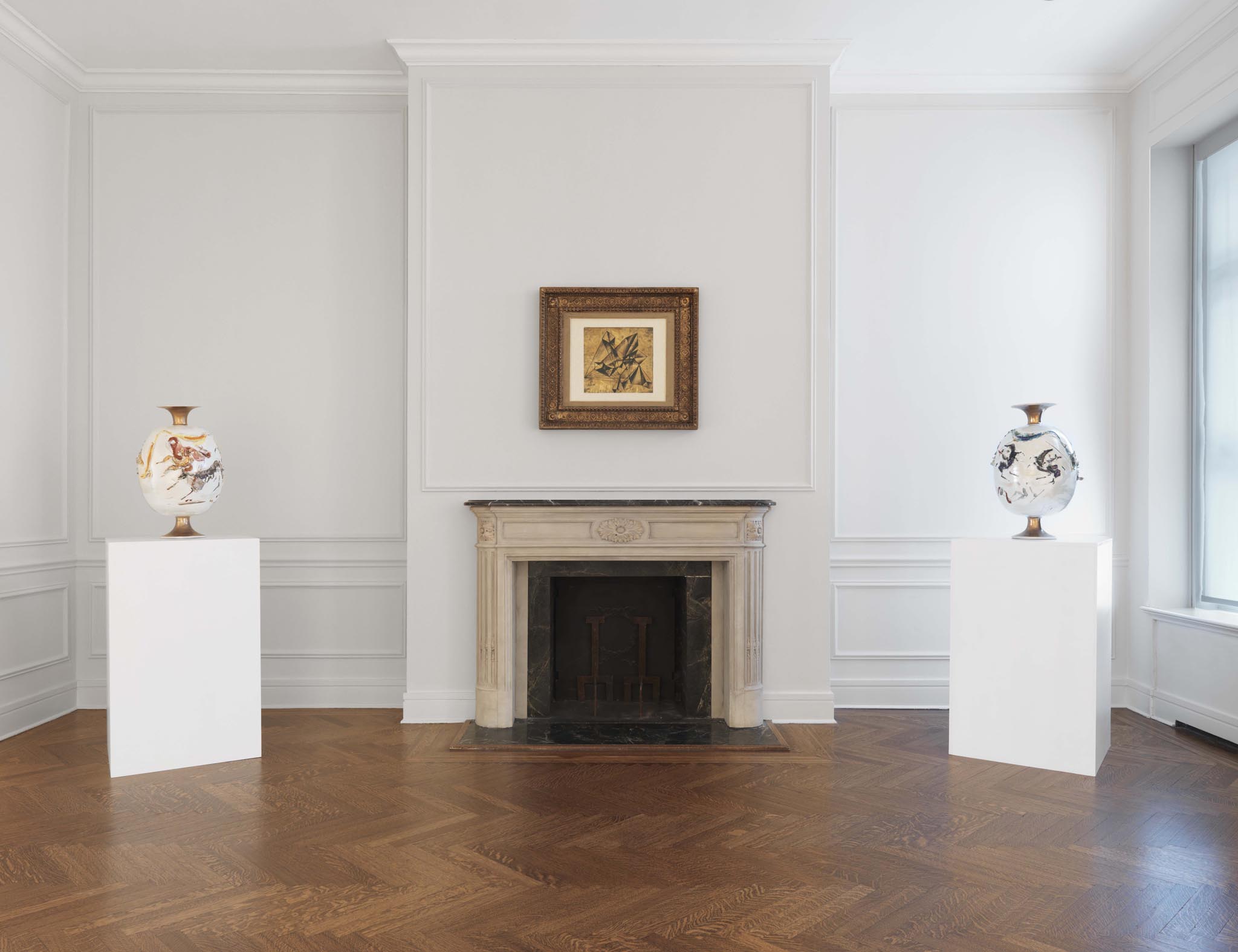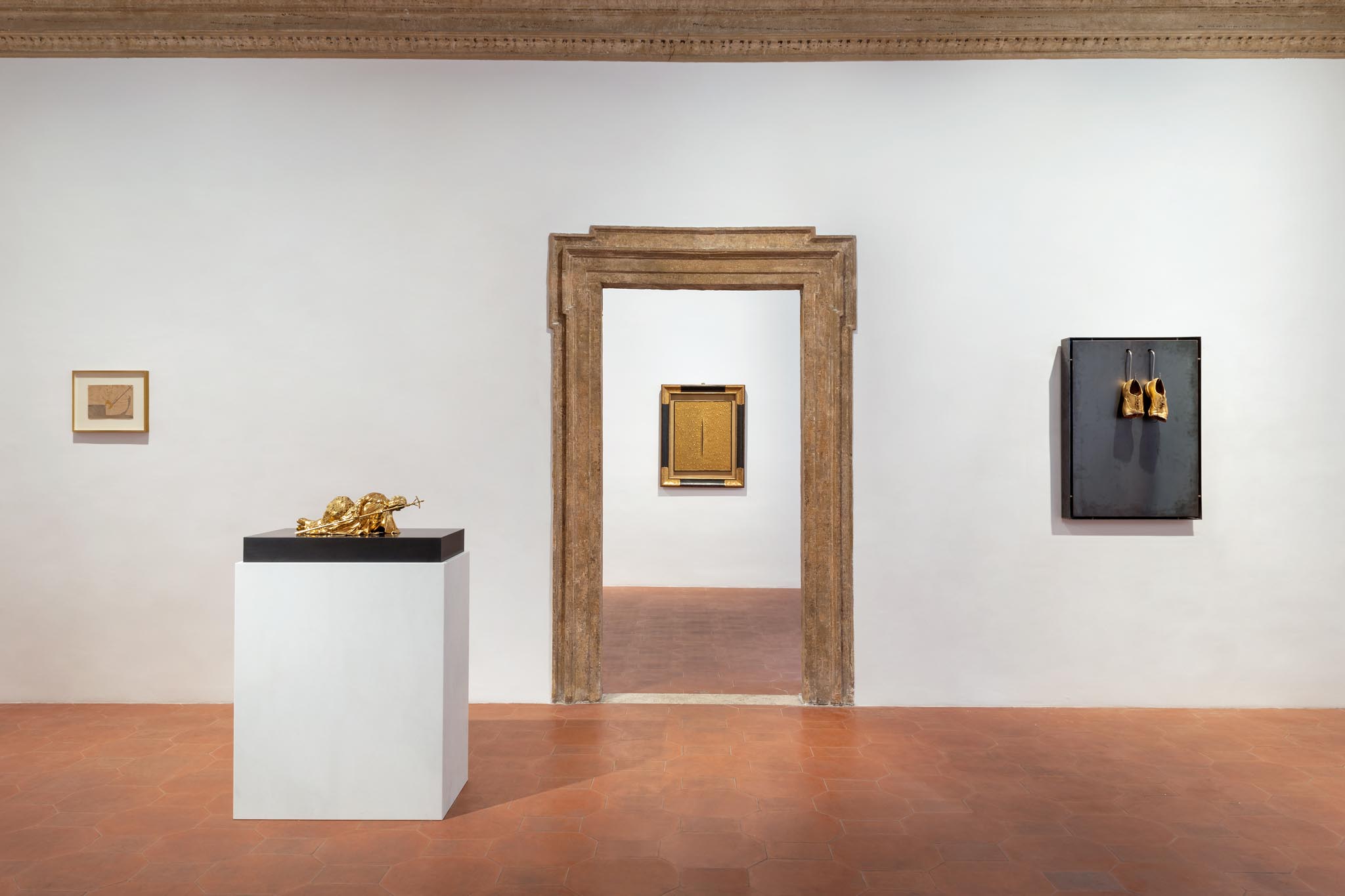Giuseppe Penone (Garessio, 1947), maintained his studio in Turin while frequently staying in Paris. His artistic journey began with exhibitions at the Deposito d’Arte Presente in Turin, followed by shows at Gian Enzo Sperone’s gallery, where he held his first solo exhibition in 1969. Penone’s oeuvre revolves around the essence of existence, revealed through his meticulous exploration of tangible elements—visual, tactile, and olfactory—found within matter. Even in his early works, Penone engaged with various materials such as lead, iron, wax, pitch, wood, plaster, and jute, each subjected to specific stresses to reveal their unique physical qualities.
In December 1968, Penone began a series of works titled Alpi Marittime, named after the forest in which he intervened, merging his actions with those of nature. This project embodied his central concept: affirming the principle of identity between man and nature.
From 1969 onward, Penone played a prominent role in the Arte Povera group, shaped by Germano Celant in 1967. He actively engaged in dialogue with contemporary international avant-gardes through a series of exhibitions. Notable among these were Konzeption-Conception at Schloss Morsbroich in Leverkusen in 1969, Conceptual Art, Poor Art, Land Art at the Galleria Civica d’Arte Moderna in Turin, and Information at the Museum of Modern Art in New York in 1970. The tree—being a living organism and bearing a striking resemblance to the human figure—occupies a central position in Penone’s artistic vocabulary. In 1969, he created his first Alberi, each crafted by peeling away a beam and meticulously following the growth rings of the plant to partially reconstruct its trunk and branches, capturing the moment in time before it was felled.
During Aktionsraum 1 in Munich in 1970, Penone conducted a public excavation of a 12-meter tree, titled Albero. This significant work was acquired the same year by Pontus Hultén for the Moderna Museet in Stockholm, marking Penone’s first inclusion in a public collection. In 1980, Penone unveiled another monumental Albero, also twelve meters high. In this piece, the tree is revealed in its entirety except for the top portion, which remains a beam and serves as the sculpture’s base. This work was showcased at the Guggenheim in New York in 1982 and later at the Musée des Beaux-Arts in Nantes in 1986. A notable addition to Penone’s repertoire is the impressive sculpture Cedro di Versailles (2002–2003). In this piece, the outline of a young tree is meticulously carved from the trunk of an ancient cedar sourced from the forest of Versailles. Penone’s exploration of the Albero theme has produced numerous variations over the years, all rooted in the concept of Ripetere il bosco (Repeating the forest).
Another prominent theme in Penone’s oeuvre is the idea of the limit, which defines the uniqueness of all things and living beings. The artist contemplates it as a boundary, emphasizing mutual contact. In Rovesciare i propri occhi (1970), Penone employs mirrored contact lenses to disrupt the visual connection between the individual and their surroundings, suggesting that photography could capture the images the eye fails to perceive. This key work marks a shift toward favoring the sense of touch in Penone’s practice. He embarks on a cycle of works titled Svolgere la propria pelle, and, reflecting on the many voluntary and involuntary marks that bodies disseminate, extends these imprints onto different elements, such as the neon lights of a gallery or the windowpanes of the Kunsthalle Fridericianum in Kassel at Documenta 5 in 1972. With the cycles Pressione (since 1974) and Palpebre (since 1977), Penone delves into the automatic and subconscious imagery of imprints, transforming them into conscious and deliberate creations through the act of drawing. This process involves enlarging and retracing the imprint in its entirety, turning it into a tangible manifestation through the indispensable act of drawing. Penone’s method typically entails photographing a print, projecting it onto various surfaces at a larger scale, and meticulously tracing it with charcoal or graphite. The contact preserved within the print serves as the foundational matrix of Penone’s works, rejuvenating traditional sculptural practices such as casting or lost-wax casting through innovative interpretation.
From 1972 onwards, Penone created a series of works featuring plaster casts of body parts overlaid with slides of the model photographed after the casting process. The inaugural piece of this series, Torace, made in 1972, was showcased in a solo exhibition at Galerie Paul Maenz in Cologne in 1973.
In contrast, Penone’s exploration of contact as an active process of memory is epitomized in the work Vaso (1975). This piece comprises an earthenware pot sourced from archaeological excavations, accompanied by four bronze sculptures enlarging the impressions left on it by the potter. Demonstrating this concept further, Penone unveiled Soffio at his solo exhibition at Museum Folkwang, Essen, in 1978. This series features terracotta works, the first of which reproduces the volume of breath against his body, manifested in clay as a vase. Notably, the mouthpiece of the vase mirrors the cast of the inside of his mouth. Soffio di foglie, created in 1979, further explores this theme, capturing the volume of breath and the imprint of the artist’s body on a pile of leaves. This work was later cast in bronze in 1982. In Gesti vegetali, a series of bronze sculptures begun in 1982 and first exhibited at the Konrad Fischer Gallery in Zurich and the Stein Gallery in Turin, as well as at the Fort Worth Museum and the Museum of Contemporary Art in Chicago, Penone “fossilizes” the traces of his hands into roughly anthropomorphic forms that intertwine with plant growth, as seen in Merian Park in Basel (1984) and at Marian Goodman Gallery in New York (1985).
Bronze sculptures also populate public spaces, exemplified by Pozzo di Münster, created for the 1987 edition of Skulptur Projekte Münster. This artwork features trees with handprints forming forks from which water flows along the trunk. Similarly, L’Albero delle vocali has been located in the Tuileries Gardens in Paris since 2000.
In Penone’s recent work, there is a marked preference for a form of knowledge grounded in analogy. This type of experience, often considered pre-logical in Western thought, is revitalized and validated by Penone through the power of imagination. While his visionary approach previously enabled him to unveil the tree’s original form or configure contact, it now guides him in associating different materials to enhance their inherent affinities.
In the expansive drawings titled Foglie, Penone translates the imprints left by the brain—a soft substance—onto the cranial cavity into images of leaves. In his series Anatomie, unveiled for the first time at the Réfectoire de l’Abbaye de Tournus in 1992, Penone meticulously carves the surfaces of Carrara marble—a revered material in sculpture—highlighting its veins, which bear a striking resemblance to the channels through which blood flows in living organisms. Several cycles followed during the 1990s and early 2000s: Propagazioni (from 1994), Respirare l’ombra (1999–2000), Pelle di foglie (from 1999), Pelle di marmo e spine d’acacia (from 2000), Pelle di grafite (from 2002), and Pelle di cedro(2002).
In the Scrigno series, showcased at the Museum of Modern Art in Bologna (MAMbo) in 2008 and at the Toyota Municipal Museum of Art in 2009, Penone diverges from the analogy between plant and animal worlds. In Lo spazio della scultura, initially exhibited at Studio per l’Arte Contemporanea Tucci Russo in Torre Pellice (Turin), Museum Kurhaus in Kleve, and Villa Medici in Rome between 2006 and 2008, he captures the imprint of tree bark on skin in bronze. Additionally, In limine (2011), a bronze tree crafted as a monumental portal for the Galleria Civica d’Arte Moderna (GAM) in Turin, features branches of roots that merge and seemingly extend into those carved into the marble block serving as its base, while its metal branches intertwine with those of a nearby linden tree. In 2002, Penone undertook a project for the former railroad loop area in Turin, designing a pathway in the shape of a tree—visible from above—that allows vegetation to grow along its course. Then, in 2007, he was invited by Ida Gianelli to create the Giardino delle Sculture fluide within the park of the Palace of Venaria.

